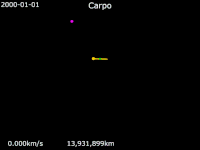Carpo (moon)
 Carpo imaged by the Canada-France-Hawaii Telescope on 25 February 2003 | |
| Discovery[1][2] | |
|---|---|
| Discovered by | Scott S. Sheppard |
| Discovery site | Mauna Kea Obs. |
| Discovery date | 26 February 2003 |
| Designations | |
Designation | Jupiter XLVI |
| Pronunciation | /ˈkɑːrpoʊ/ |
Named after | Καρπώ Karpō |
| S/2003 J 20 | |
| Adjectives | Carpoan /kɑːrˈpoʊən/ or Carpoian /kɑːrˈpoʊ.iən/ |
| Orbital characteristics[3] | |
| Epoch 1 January 2000 (JD 2451545.0) | |
| Observation arc | 15.25 yr (5,571 d)[4] |
| Earliest precovery date | 9 February 2003[4] |
| Satellite of | Jupiter |
| Group | Carpo |
| Proper orbital elements | |
Proper semi-major axis | 17,042,300 km (0.113921 AU) AU |
Proper eccentricity | 0.416 |
Proper inclination | 54.0° (to ecliptic) |
Proper mean motion | 288.174132 deg / yr |
Proper orbital period | 1.24924 yr (456.287 d) |
Precession of perihelion | N/A arcsec / yr |
Precession of the ascending node | 11546.8914 arcsec / yr |
| Physical characteristics | |
| ≈3 km[5] | |
| Albedo | 0.04 (assumed)[5] |
| 23.0[5] | |
| 16.2[4] | |
Carpo /ˈkɑːrpoʊ/, also Jupiter XLVI, is a small outer natural satellite of Jupiter. It was discovered by a team of astronomers from the University of Hawaii led by Scott S. Sheppard in 2003, and was provisionally designated as S/2003 J 20[6][7] until it received its name in early 2005.[8] It was named in March 2005 after Carpo, one of the Horae, and a daughter of Zeus (Jupiter).[2]
Carpo has a diameter of about 3 km (1.9 mi) for an absolute magnitude of 16.2.[5][4] Like all irregular moons of Jupiter, Carpo's orbit is highly variable over time due to gravitational perturbations by the Sun and other planets.[9] On average, Carpo's orbit has a semi-major axis of 17.0 million km (10.6 million mi), a high eccentricity of 0.42, and a very high inclination of 54° with respect to the ecliptic.[5]
Carpo was long thought to be an outlier prograde satellite not part of any group, until S/2018 J 4 was found.[5] The orbital inclination of satellites such as Carpo is limited by the Kozai effect, which induces a periodic exchange between the inclination and eccentricity of the orbit. If the inclination is large enough, the eccentricity can in turn grow so large that the periapsis of the satellite (called the perijove in the case of moons of Jupiter) would be in the immediate vicinity of the Galilean moons (Io, Europa, Ganymede and Callisto). The satellite would eventually collide with one of these, or a close encounter would eject it altogether from the Jovian system. Due to the Kozai effect, Carpo's argument of periapsis never precesses and instead librates about 90° with respect to the ecliptic, which keeps Carpo's perijove always above Jupiter and its apojove below (see orbit animation below).[9]
References
[edit]- ^ "Planetary Satellite Discovery Circumstances". JPL Solar System Dynamics. NASA. Retrieved 25 January 2023.
- ^ Jump up to: a b "Planet and Satellite Names and Discoverers". Gazetteer of Planetary Nomenclature. IAU Working Group for Planetary System Nomenclature. Retrieved 25 January 2023.
- ^ "Planetary Satellite Mean Elements". JPL Solar System Dynamics. NASA. Retrieved 25 January 2023.
- ^ Jump up to: a b c d "Natural Satellites Ephemeris Service". Minor Planet Center. Retrieved 20 January 2023. Selection of Objects → "All Jovian outer irregular satellites" → Check "I require Orbital Elements" → Get Information
- ^ Jump up to: a b c d e f Sheppard, Scott S. "Moons of Jupiter". Earth & Planets Laboratory. Carnegie Institution for Science. Retrieved 25 January 2023.
- ^ Daniel W. E. Green (30 April 2003). "IAUC 8125: S/2003 J 19 and S/2003 J 20". International Astronomical Union. Archived from the original on 5 March 2016.
- ^ MPEC 2003-G67: S/2003 J 20 2003 April (discovery and ephemeris)
- ^ Daniel W. E. Green (30 March 2005). "IAUC 8502: Satellites of Jupiter". International Astronomical Union.
- ^ Jump up to: a b Brozović, Marina; Jacobson, Robert A. (March 2017). "The Orbits of Jupiter's Irregular Satellites". The Astronomical Journal. 153 (4): 10. Bibcode:2017AJ....153..147B. doi:10.3847/1538-3881/aa5e4d. S2CID 125571053. 147.


